पनरे सौ पैंताळवे, सुद बैशाख सुमेर |
थावर बीज थरपियो, बीके बीकानेर ||
534 Years of Guts & Glory.
A scion of the Rathore Rajput clan, established the city of Bikaner in 1488. He was son of Rao Jodha Rathore, Story regarding the foundation of this Desert Kingdom is that, One day Bika and his uncle Kandhal enter the Marwar court ,
Rao Jodha asks "What are the unkle and nephew advising? Is there any talk of winning a new kingdom?
Kandhal Rathore said, "It will happen to your glory"
After this incident, Biika and Kandhal took permission from Rao Jodha and set out to establish new kingdom. राव बीका ने संवत् १५४५ में बैसाख मास की द्वितीय तिथि को बीकानेर की स्थापना की थी।
This is also described in the death memorial of Rao Bika
श्रुत्वा मितृवचः प्रणाममकरोद् भूपानुजप्रेरितः । हत्वा शत्रुवनं स्वभिक्ष (१). सहित राज्यं वरं प्राप्तवान् ।
Meaning - Hearing the father's word, Bika bowed and inspired by the younger brother (Kandhal) of the king (Jodha). After destroying the group of enemies, he gained a new kingdom.
Rao Bika Deshnok reached and received the blessings of Karani Mata she said "Your glory will be more than that of Jodha and many masters will be your servent "
Rao Shekha, the ruler of Pugal was taken captive by the Sultan of Multan, Rao Bika attacked and rescued Shekha and married Shekha's daughter.
Rao Bika started to build a fort in Jangalpradesh and built the city of Bikaner in his name,
couplet is famous in this regard
पनरे से पैतालवे, सुद वैशाख सुमेर ।
थावर बीज थरप्पियो, बीके बीकानेर ।।
Rao Bika took revenge for the death of his uncle Kandhal Rathore by killing the Sarang Khan of Hisar, Rao Bika expanded his kingdom by defeating Jats, Even though Bika ji defeated these chiefs of Jats, he respected them and for that the Jat chiefs swore alleigence to the Rathore king. After that recruitment of Jats started in Bikaji's army which previously consisted almost entirely of Rajputs. at that time, the border of Bikaner kingdom was as far as Hisar in Punjab, Rao Bika's personality was generous, brave and truthful.
Just as the name of Rawat Chunda is famous in the history of Mewar for his devotion to his father, so is the name of Rao Bika in the history of Jodhpur and Bikaner.
Maharajas of Bikaner
Sardar Singh
Dungar Singh
Ganga Singh
Sadul Singh
1851-1872
1872-1887
1887-1943
1943-1950
To Dungar Singh was granted:
Arms: Barry of six Gules and Or, three falcons close Argent, each charged with a trident Gules.
Crest: On a helmet affrontée, lambrequined Gules and Or, a green tree.
Supporters: Two leopards Sable.
Motto: JAYA JAIGALDAR BADSAH (Victory to the Emperor Jaigaldar)
Ganga Singh bore:
Paintingof the achievement, Bikaner Palace
2. The same, the tridents lacking, the motto changed.
3. On a flag parted per fess yellow and red, today in Jodhpur Museum, the achievement is:
Arms: Or, three bars Azure, Gules and Vert, 3 falcons close Argent on the bars Azure and Vert, 2 and 1.
Crest: On a helmet affrontée, lambrequined Gules and Or, a green tree.
Supporters: Two leopards Argent
Motto: In golden lettering on a ribbon Azure.

Junagarh Fort is included in the main fort of Rajasthan which is not built at the height of the mountain. The present Bikaner city has developed around the fort. The Junagarh Fort is in the city of Bikaner in the Indian state of Rajasthan. The Junagarh fort bikaner is famous for monument fort, history, architecture, culture, photography.
This fort is actually known as Chintamani Fort and Bikaner Fort and was renamed Junagadh in the early 20th century as the family residing in the fort shifted to Lalgarh Palace in the 20th century.
The Junagarh fort was constructed under the supervision of Prime Minister Karan Chand of Bikaner ruler Raja Rai Singh, Raja Rai Singh ruled Bikaner between 1571 and 1611 AD.
The construction of the Junagarh fort walls and moat began in 1589 and was completed in 1594. They have been built outside the original fort of the city, these walls and trenches were constructed at a distance of 1.5 km from the city center. The remaining part of the Junagadh Fort is built around the Lakshmi Narayan Temple.
According to historical documents, Junagarh Fort was attacked many times by enemies, but no one could ever get it, only Kamran Mirza kept it under his control for a day.
A palace, temple, and theater are built in the complex of the fort of Acker. These buildings reflect the mixed architectural art of the time. Kamran was the second son of the Mughal emperor Babur who invaded Bikaner in 1534, and after this Bikaner was ruled by Rao Jit Singh.
Fort Of Junagarh Bikaner Rajasthan
The ancient city of Junagadh is named after an old fort. It is located near the Girnar mountain. The sites of the pre-Harappan period have been excavated here. The city was built in the ninth century.
It was the capital of the Chudasama Rajputs. It was a princely state. On the way to Girnar is dark basalt rock, inscribed representing three dynasties. The Mauryan rulers Ashoka (circa 260–238 BCE) Rudradaman (150 AD) and Skandagupta (circa 455–467). There is also a stupa with caves made by Buddhists during 100–700 AD. Several temples and mosques located near the city reveal its long and complex history.
Here in the third century BC Buddhist caves, Emperor Ashoka’s mandate engraved on stone and Jain temples are located somewhere on the peaks of Girnar mountain. Junagadh, the fortress of Rajputs until the 15th century was captured in 1472 by Mahmud Begha of Gujarat, who named it Mustafabad and built a mosque here, which is now in ruins.
Junagarh Fort still proudly narrates its history and says that no ruler has ever defeated me. It is said that only once in history, there is mention of an attempt by a non-ruler to capture this grand fort.
Mughal ruler Kamran is said to have succeeded in seizing the throne of Junagadh and conquering the fort, but he had to leave the throne within 24 hours. Apart from this, there is no mention that Junagadh had any intention of defeating any ruler and he was successful.
Deserting Rajasthan in the rainy season, especially in the old era when it was a festival for the rainy Rajasthan, during that time, the King-Maharaja used to realize the rain by building a Badal Mahal in the royal fort of the state.
Badal Mahal built in many forts including Jaipur, Nagaur forts are examples of this, but the Junagadh fort of Bikaner is very popular for the specially built Badal Mahal.
This magnificent palace built at a very high altitude in the Junagadh fort complex is called Badal Mahal because it is situated at the highest height in the fort.

Upon reaching the palace, it really feels like you have come to a cloud of the sky. The walls adorned with blue clouds give a feel of the showers of Barkha. The fresh air flowing here touches all the tiredness of the tourists.
History is associated with this entire Junagarh Fort to very deep roots, so the tourists are very attracted to it. This fort is entirely made of red sandstone of the Thar Desert. However, marble work has been done within it. There are many wonderful things to see in this fort. Here the king has a rich heritage with many Havelis and many temples.
Some of the palaces here include Ganga Mahal, Phool Mahal, etc. including ‘Badal Mahal’. There is also a museum in this fort which also has clothes, paintings, and weapons of historical importance. This museum is one of the special attractions of Rajasthan for tourists.
Here you will also find many manuscripts written in Sanskrit and Persian. The museum inside the Junagadh Fort is the biggest attraction for tourists in Bikaner and Rajasthan. This fort museum has some very rare paintings, jewelry, weapons, biplanes, etc. of the First World War.
According to historians, the foundations of the finds of this fort were laid on Thursday, 30 January 1589. Its foundation stone was laid on 17 February 1589.
Its construction was completed on Thursday 17 January 1594. Architectural, archaeological and historically significant, the Turkish style was adopted in the construction of this fort in which the walls are tilted inwards. Palaces in Delhi, Agra, and Lahore is also reflected in the palace built in the fort.
The fort is in a quadrangular shape, built in a circumference of 1078 yards and has 37 bastions on average 40 feet in height, surrounded by walls from all sides. This fort has 2 entrances – Karan Prowl and Moon Prowl. Karan Pral is made in the east direction with 4 gates and Chand Pral is made in the west direction, which is the only gate protected by Dhruva Pral.
All the proles are named after the principal rulers and princes of the royal family of Bikaner. Many of these proles are such that preserve the fort. In olden times, no war was considered to have been won until the fort was conquered there.
Enemies had to cross a deep moat, then cross strong walls, then proles had to be captured to enter the fort. The doors of the proles are made of the very heavy and strong wood. It has solid iron speckled nails.

Anup Mahal is a multi-story building, which used to be the headquarters of the empire in history. Its ceiling is made of wood and glass, as well as Italian tiles and lattice windows and balconies were used in its construction. Some artifacts have also been made in this palace with gold leaves. It is also considered a huge construction. Junagadh Fort and Bikaner’s Palace-
Phool Mahal is the oldest part of the fort which was built by Raja Rai Singh of Bikaner, who ruled from 1571 to 1668.
The Ganga Mahal was built in the 20th century by Ganga Singh, who ruled for 56 years from 1887 to 1943, the fort has a huge Durbar Hall, also known as Ganga Singh Hall.
Bikaneri Haveli is a beautiful example of Bikaner’s special and famous architecture, both inside and outside the city of Bikaner. Aldous Huxley, a foreign tourist who visited Bikaner, said, “These Havelis are the pride of Bikaner”.
Karan Mahal (Public Audience Hall) was built by Karan Singh in 1680 C. It was built in the victory of the Mughal Emperor Aurangzeb. A garden has also been constructed near this palace and it is included in the famous and huge kilo of Rajasthan. This fort reflects the historical architecture of Rajasthan.
The windows of the fort are made of colored glass and the intricately painted balconies have been made of wood. Later, Rajas, Anup Singh, and Surat Singh also repaired the palace, made it shiny, got the glass and also painted red and golden paint.
Badal Mahal is a part of the existence of Anup Mahal. It has a painting of Shekhawati Dundlod, who is paying respects to the Maharaja of Bikaner in the different turban. It also has photographs of people standing on nails, wood, swords, and saws. On the walls of the palace, there are also pictures of Hindu God Shri Krishna.The throne room also has a strong niche that is used as a throne.
Chandra Mahal is the most magnificent and magnificent room of the fort, there are artifacts and paintings of deities made of gold, in which precious gems are also studded. In this royal bedroom, the glass is placed in such a way that the king can see whoever is entering his room as he sits on his bed.
Maharaja Rai Singh Trust was built by the royal family of Bikaner. So that more and more information about the history of the fort can be conveyed to the tourists. Along with this, the main objective of establishing this trust was to develop education, culture, and people in the state.
The Fort museum built within the fort is named Junagadh Fort Museum, which was established in 1961 by Maharaja Dr. Karni Singh under the control of “Maharaja Rai Singh Trust”.
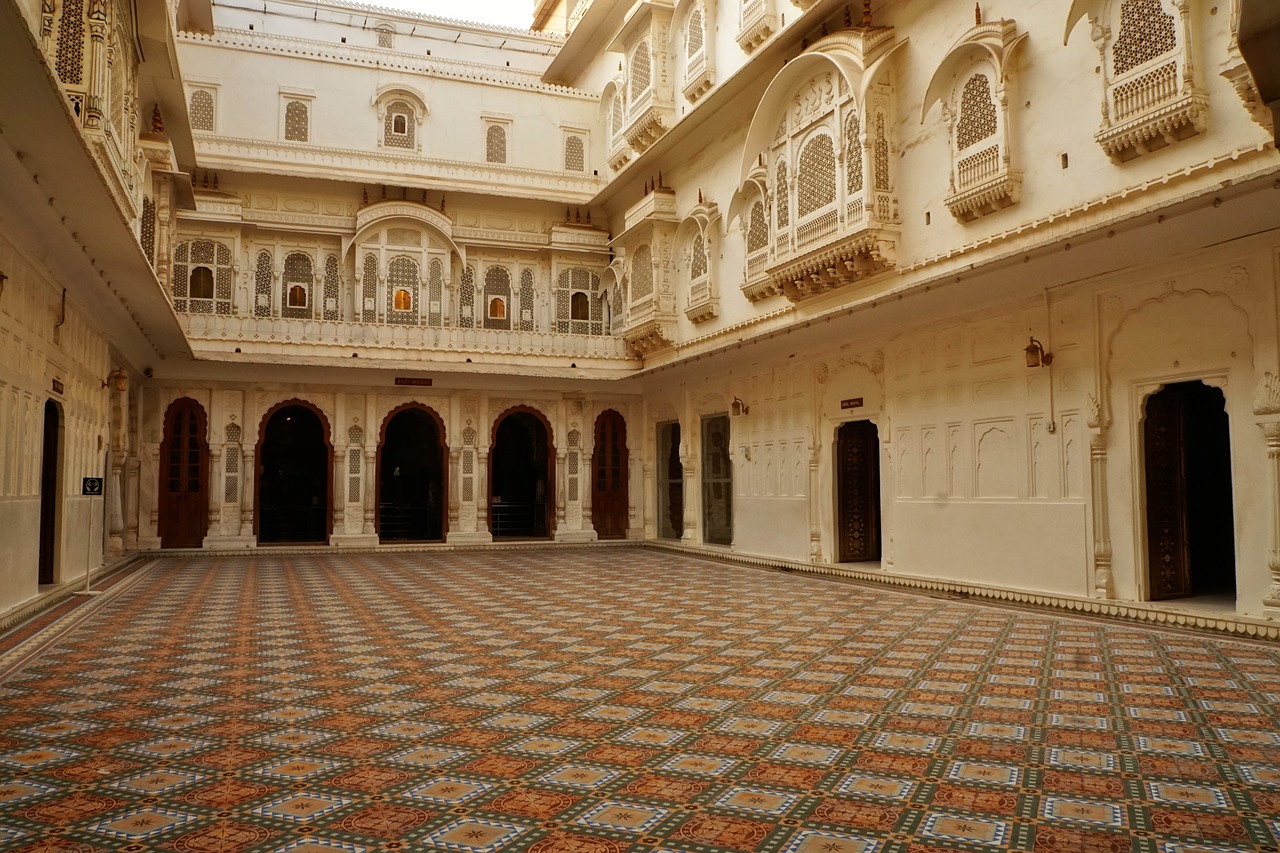
The museum exhibits Persian and Manusmriti, historical paintings, jewelry, royal costumes, royal decrees, galleries, customs and statues of the supposed Lord. The museum also has an armory in which memories of past wars have been decorated.
Bikaner was founded by Rao Bika, the second son of Rao Jodha (the founder of Jodhpur) in 1488. It is said that Bika did not have very good relations with his father and brothers and in exchange for giving up his claim to the throne of Jodhpur, was allowed to take the heirlooms of the Rathore dynasty with him when he left Jodhpur forever. However, rivalry between the two kingdoms lasted till the 19th century. Sometimes, this rivalry even escalated into open warfare.
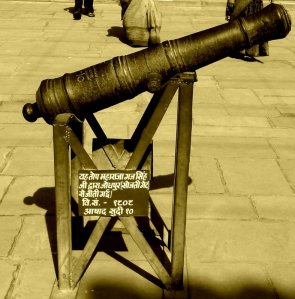
In one of the courtyards inside the palace in the Fort is a cannon captured by Maharaja Gaj Singh, the 14th ruler of Bikaner, in 1808. As cannons go, this one is a baby cannon. But the pride of place it has got for display indicates that capturing this cannon must have been a matter of great prestige for Bikaner.
The Junagarh Fort is not the first fort built in Bikaner; Rao Bika had built a stone fort when he founded this city. But today, only scattered fragments of Rao Bika’s original fort survives.
Unlike most forts in Rajasthan and elsewhere in India, the Junagarh Fort of Bikaner is a land fort. It’s foundations were laid in 1589 by Maharaja Rai Singhji, the 6th ruler of Bikaner. Known as Chintamani Durg, construction of the Fort was completed in 1593 and 20 kings have resided in the Fort since then till 1902 when the royal family moved out into Lalgarh Palace. And that’s when the name Junagarh Fort came about. The Fort was “donated” to the Maharaja Rai Singhji Trust in 1968 by the 23rd ruler of Bikaner, Maharaja Karni Singhji. Since then, the Junagarh Fort has been open to the public.
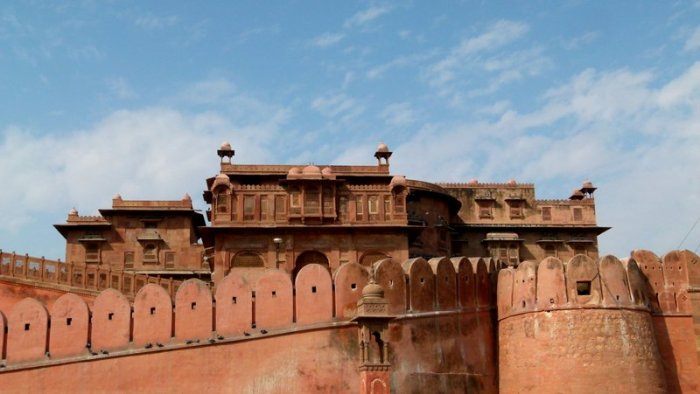 View of the Junagarh Fort from the main entrance
View of the Junagarh Fort from the main entrance
The Junagarh Fort is built from red sandstone and with its cluster of low-rise buildings within has never been conquered, in spite of many battles fought in the area. And you realise why only when you enter the Fort. A land fort it may be, but the Junagarh Fort has all possible defense mechanisms in place. There is a deep, but currently dry, moat surrounding the fort walls. Then there are a series of gates that one has to pass through (each one accessed after twists and turns).
The gates are fitted with wicked looking nails at “elephant height”, that is at the height of an elephant’s head. Since elephants were used to batter down the defensive gates in forts, the nails acted as a deterrent for elephants to ram their heads on the gates.
After passing through all the gates, one enters the ceremonial courtyard to get that first breathtaking glimpse of the palace façade, which hints at the architectural treasures within. The lower levels are built of red sandstone and the upper levels from yellow sandstone. This uniform architectural style on the exterior hides a series of buildings that were built at different times by different rulers and with different architectural elements.
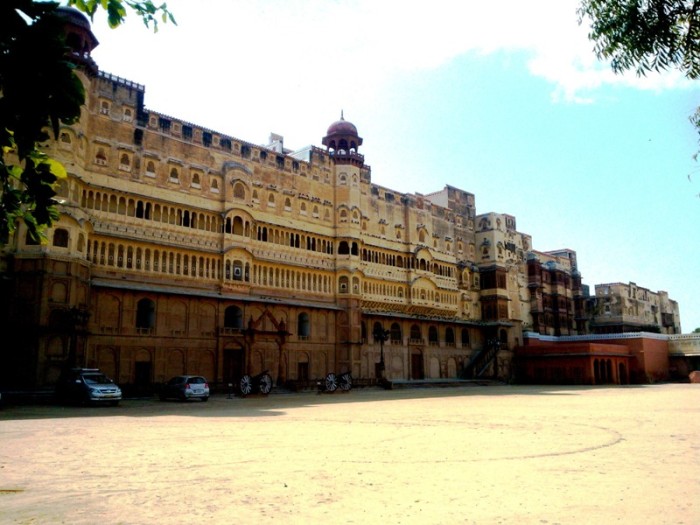 View of façade of the Palace inside the Junagarh Fort
View of façade of the Palace inside the Junagarh Fort
 View of façade of the Palace inside the Junagarh Fort
View of façade of the Palace inside the Junagarh Fort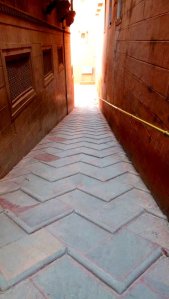
The palace complex is accessed through a narrow, steep ramp (see photo on left) which leads into the first of the many courtyards around which the rooms in the palace are arranged. Each courtyard is different — if one courtyard is built entirely of red sandstone, another is built with sandstone and some marble, a third is almost entirely made of marble with coloured tiling, another with painted frescoes, and yet another with inlay work.
The rooms leading off from the courtyards are also vastly different. If the Karan Mahalor the public audience hall was built with Mughal architectural influences, there was Anoop Mahal or the Privy Council Room which has some dazzling gold inlay work interspersed with some real gems like emeralds and rubies. Then there was the delicate Phool Mahal, the oldest part of the palace complex, with motifs of flowers as stucco work and glass inlay work, and the grand and cavernous Durbar Hall with the ceremonial 1,100-year-old sandalwood throne.
But the ‘mahal’ that literally took my breath away was Badal Mahal or the palace of clouds. The longing for rain in an arid area like Bikaner has been captured on every inch of the walls in the Badal Mahal with blue clouds interspersed with lightning motifs painted on its walls and ceilings.
 Looking down from the gallery into one of the courtyards
Looking down from the gallery into one of the courtyards A beautifully painted fresco on one of the walls of the palace complex at Junagarh Fort
A beautifully painted fresco on one of the walls of the palace complex at Junagarh Fort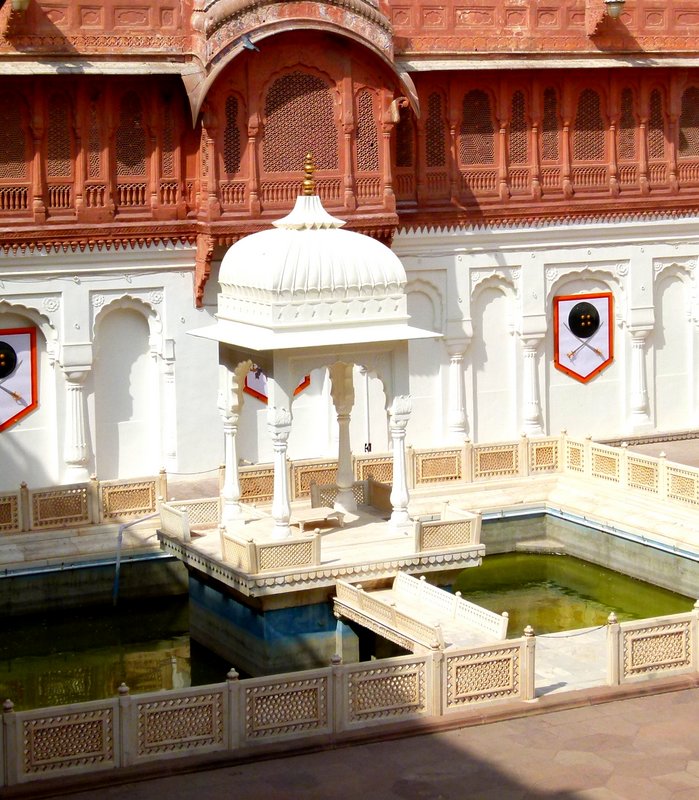
The Maharaja of Bikaner would hold court from the marble throne here sometimes

The grand interiors of Anoop Mahal. Foreign dignitaries and important officials were received here
 A beautifully painted corridor
A beautifully painted corridor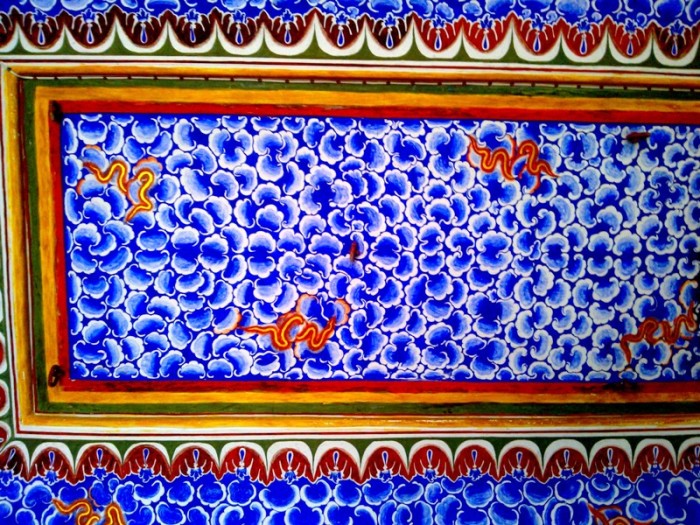 Detail from the ceiling at Badal Mahal. Note the sinuous streaks of golden-yellow lightning amidst the blue of the clouds
Detail from the ceiling at Badal Mahal. Note the sinuous streaks of golden-yellow lightning amidst the blue of the clouds
A jharokha clad with blue tiles from Delft
The palace complex is full of dazzling objects like a silver throne, a sandalwood throne, a golden swing, palanquins and howdahs used by the royal family, and even a Haviland Plane, among hundreds of other objects. This plane, which is displayed in the Vikram Niwas Durbar Hall, was pieced together from the parts of two shot down DH-9DE Haviland Planes.
The Junagarh Fort also houses Pracheena, a museum that displays contemporary arts and crafts, ritual crafts, period furniture, textiles and costumes used by the royal family, royal photographs and miniatures, among many others. This museum is a veritable treat for the eyes and gives a glimpse into the everyday life of the royals. There are framed menus on display as are the delicate crockery and cutlery. Two display items caught my eye.
 Leheraiyas, bandhanis, gota work…
Leheraiyas, bandhanis, gota work…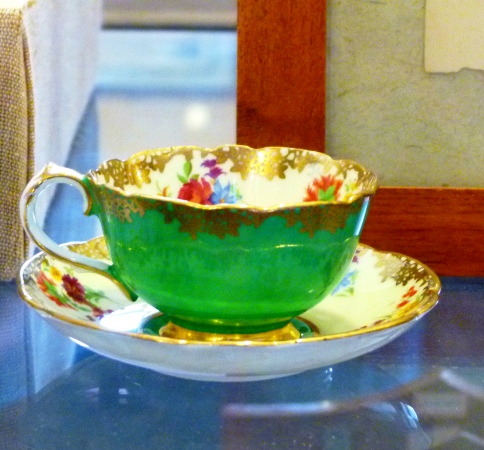 Oh, for a cup of tea !
Oh, for a cup of tea !
 Leheraiyas, bandhanis, gota work…
Leheraiyas, bandhanis, gota work… Oh, for a cup of tea !
Oh, for a cup of tea !
Only a small portion of the Junagarh Fort is open to the public and it took normally about 2-3 hours to cover it thoroughly. As one walked out, they would notice something they had missed seeing while coming in: handprints of royal women who had committed sati. It was a sobering sight and somehow would glad to saw it on their way out rather then on their way in.
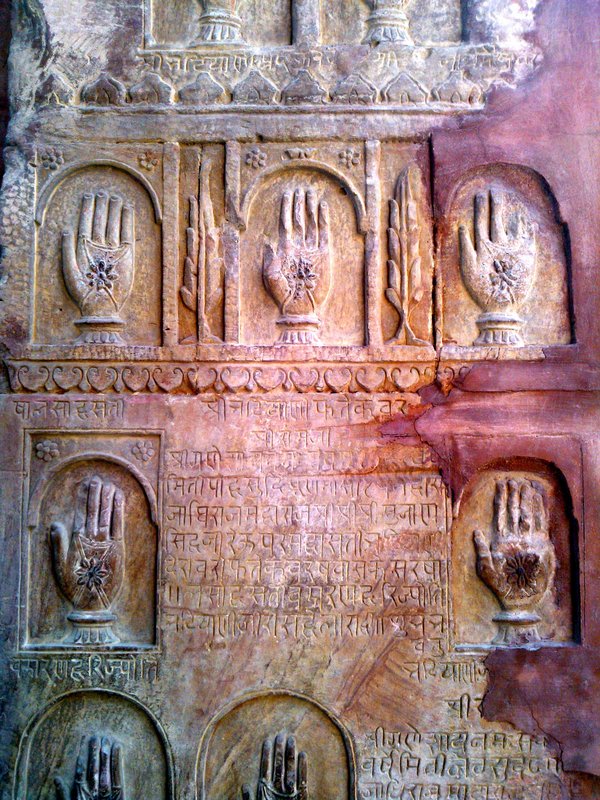
Handprints of women from the royal family who committed sati

Handprints of women from the royal family who committed sati

LALGARH PALACE
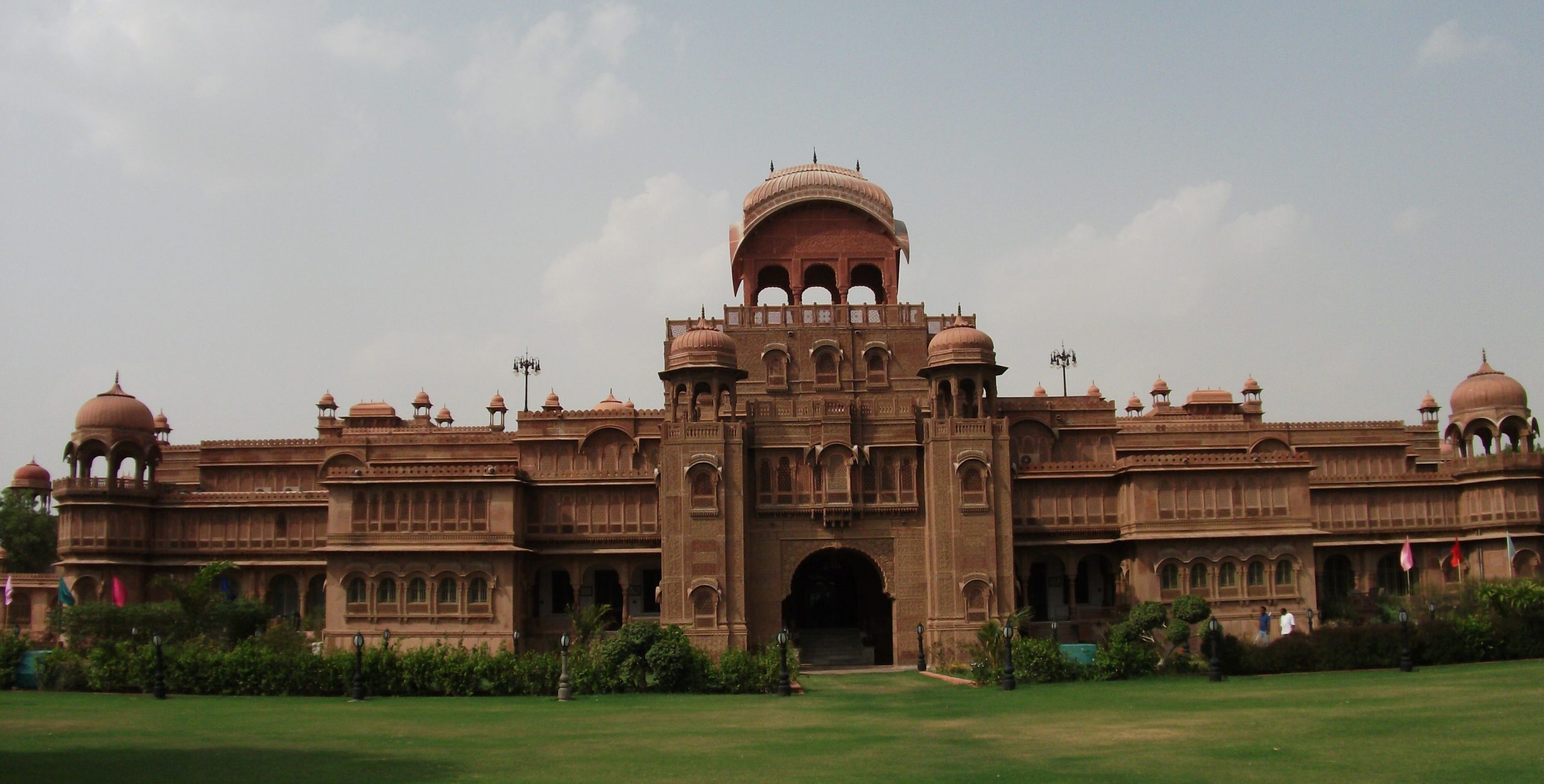
Lalgarh Palace is a heritage hotel of Bikaner in Rajasthan, built-in The indo-Saracenic style between 1902 and 1926 by Maharaja Ganga Singh of Bikaner in memory of his father Maharaja Lal Singh.
Lalgarh Palace is very grand among the buildings outside the city. The city of Bikaner and Junagarh Fort is approx 03 kilometers from this palace.
History of Lalgarh Palace Bikaner Rajasthan
This the palace was built by the British, as the British believed that the king was inappropriate for the current Junagar palace, so they built this palace for the king. The Laxmi Niwas Palace is a part of the Palace Lalgarh, which was completed in 1902. In 1972,
The Maharaja of Bikaner, Karani Singh, M.P., established the Ganga Singhji Charitable Trust and the Maharaja used a portion of the Palace Lalgarh to be used in the service of the trust as a service to the trust.
Lord Curzon was the first notable guest of the palace. Currently, Palace Lalgarh is owned by his daughter Princess Rajyashree Kumari.
Lalgarh Palace Bikaner Architecture
The Lalgarh Palace is a classic example of Indian, European, and Mughal architecture. The Palace Originally built at a cost of Rs 100,000, the Lalgarh palace was designed by the British architect Swinton Jacob.
But as time progressed, the cost of its construction increased by Rs 1 million. The whole palace of Sara is made of red stone, on which there is a great work of excavation. The inner floors are often of marble.
Part of the palace has been converted into a heritage hotel and a museum that is famous as the Sri Sardul Museum. The museum is built on the first floor of the palace and has preserved old paintings and traces of wildlife.
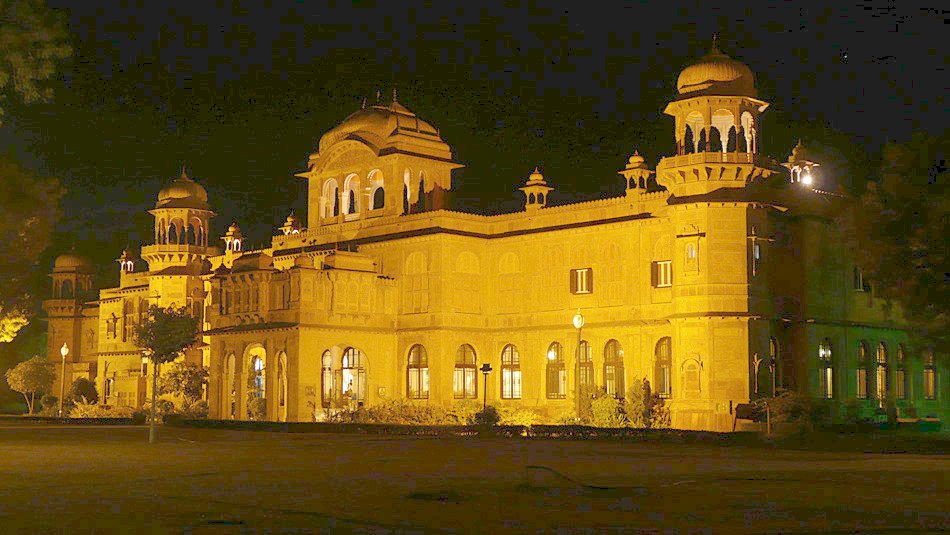
Located in the western part of the palace, the “Sri Sardul Museum” contains the fourth largest private library in the world
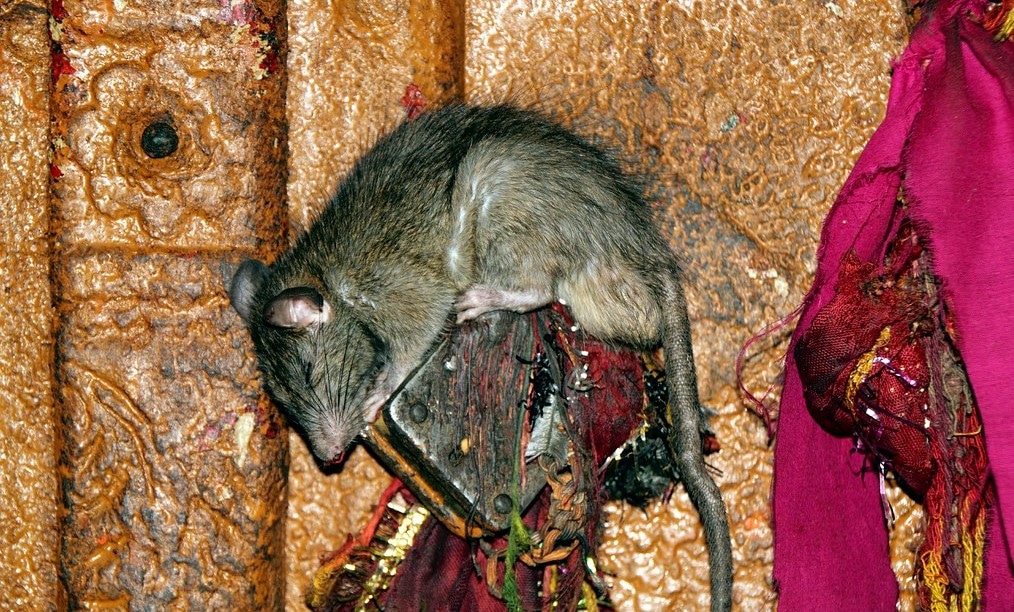
Karni Mata Temple is located in Deshnok of Bikaner district of Rajasthan. Which is located about thirty kilometers from the district headquarters of Bikaner rajasthna.
The temple of Karni Mata is also known as the Temple of Rats. Because there are thousands of rats in Mata’s temple. Who can be seen here always having fun and jumping.
Thousands of black colored rats along with white colored mice are found in Karni Mata temple. These mice are called Kaaba.
Excessive mice can be inferred that devotees have to drag their feet from the main gate of the temple to reach the main statue inside.
Because if you walk with your feet raised, the rats can come under your feet. Due to which the rat may be injured, which is considered inauspicious in the temple of mother.
“It is believed that if a devotee sees a white mouse in the temple premises of Mother, then that devotee must fulfill your wish.”
The surprising thing in Mata’s temple is that, even after thousands of rats, there is no dirt in the temple premises. And no smell comes in the temple premises. And till date there is no disease spread in the temple premises of Karni Mata.
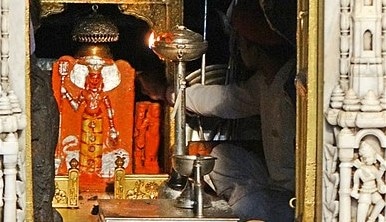
In this unique temple of Rajasthan, rats are offered milk, laddus and other dishes and the devotees visiting Karni Mata temple get false offerings of mice. And till date no devotee got sick from eating false offerings.
One of the special things about the rats of Karni Mata temple is that, when the temple is dedicated to Mata Karni aarti in the morning and evening. During this time most of the rats come out of their bills. And a lot of fun and jumping.
Story of the Mouse of karni mata Temple Deshnok Bikaner
According to local people, the mice found in the temple complex of Mata have a different story. According to which, it is said that once an army of about 20,000 soldiers came to attack Deshnok. Then Karni Mata gave the rats to all soldiers with her glory. And later he put all those mice in his service.
According to another story, it is said that for these mice in the temple, these rats are believed to be descendants of Mata Karni.
“Karni Mata, devotees and local people consider the incarnation of Mother Jagadamba.”
karni mata ki katha | Karni Mata Story, Deshnok Bikaner
Karani Mata was born in 1387 in a Charan family. His childhood name was Raghubai. Raghubai was married to Kipoji Charan of Vatika village. But after a few years of marriage, Raghubai’s mind became bored with worldly life.
Due to this, Raghubai married Kipo ji with his younger sister Gulab. And later Raghubai renounced the worldly life and devoted herself to the service and devotion of the people.
Due to public welfare, supernatural work and miraculous powers, Raghubai is revered by locals as Karani Mata. It is believed that Karni Mata lived for about 150 years.
According to local people, in the present place where the temple of Mata Karni is located, Karni Mata worshiped her mother Goddess in a cave located at the same place. This cave is still located in the temple complex.
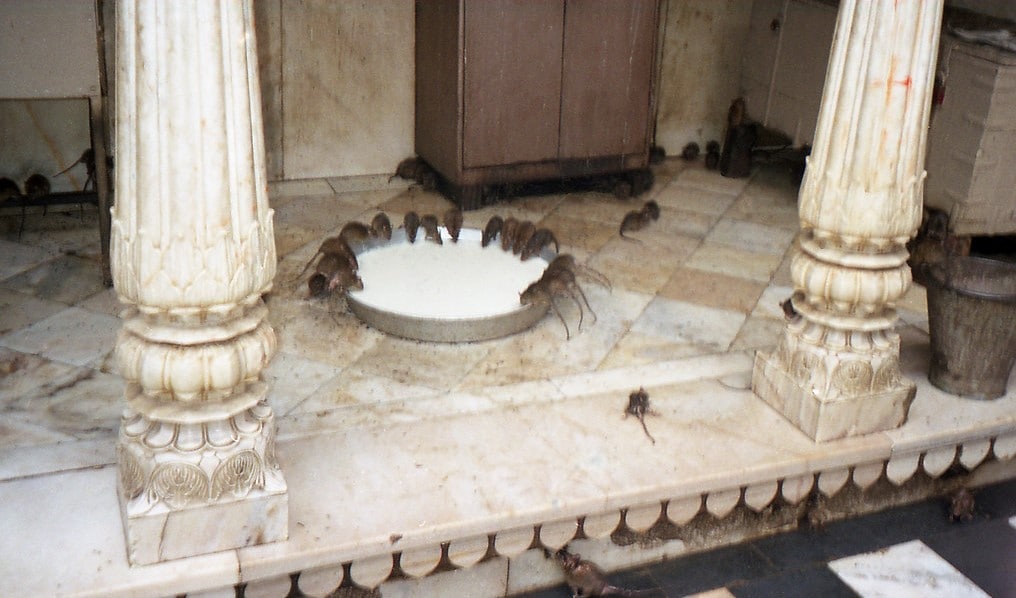
It is said that after living for about 150 years, Mata Karni became Jyotirlin in 1538 AD. After which the idol of Karni Mata was installed in this cave. Then later Maharaja Ganga Singh of Bikaner built the temple of Karni Mata here. Presently the faith of thousands of devotees is attached to this temple.
The temple of Mata Karni is built using magnificent Rajput architectural style. The temple of Mata Karni is made of stones of Sangammar. This temple is very attractive and beautiful to see.
Maharaja Gaj Singhji of Bikaner
worshiping goddess Karni Mata
Karni Mata ji is worshipped by Rulers of Bikaner and Maru region including kingdoms like Jodhpur, , Jaisalmer and others
Karni Mata ji was revered and worshipped by Rao Jodha of Jodhpur and Rao Bika, founder of Bikaner, and she supposedly laid the foundation stone of forts at both, Jodhpur and Bikaner.
In this depiction, Maharaja Gaj Singh I, the 14th Maharaja of Bikaner is shown worshipping or pleading in front of an idol of Karni mata. She is depicted as seated on a golden throne placed in the outdoors on a white platform (and not inside a shrine). Mata’s imagery is white complexioned, has four arms (holding various attributes) and gora and kala Bhairava are shown clinging around her feet.
Shiva Bari Temple
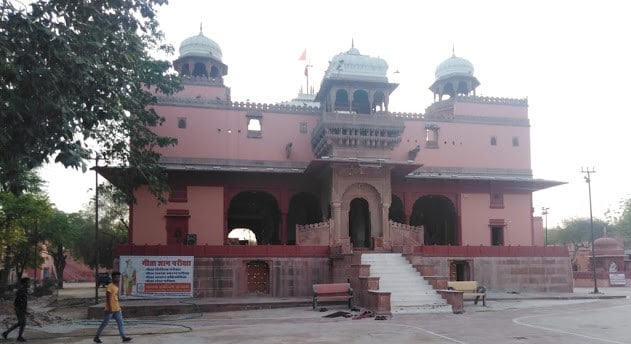
Shiva Bari temple is one of the major attractions of Bikaner in Rajasthan. It is located 5 kilometres from Bikaner Railway Station. Local people also know it by the name of Laleshwar Mahadev. Shiv Bari Temple was constructed by Dungar Singh during the 19th century.
Laleshwar Mahadev Templae Bikaner
Shiva Bari, built with red sandstone stones, is a magnificent spectacle of temple architecture. The main features of Shiva Bari Temple are its pavilion, dome, and beautiful pillars. The Shiva Bari temple is surrounded by a large stone wall from which this temple gets a different and quiet character. The main attraction of the Shiva Bari temple is the statue of Lord Shiva made of marble. This temple has a bronze statue of the holy Nandi living with Lord Shiva.
There are two sparrows in Shiva Bari temple of Bikaner. The outer part of the Shiva Bari temple is also very beautiful. In the month of Savan, thousands of devotees come to Lord Shiva’s temple and worship. This temple made of red sandstone attracts a large number of devotees

The only temple where 40000 kg of pure ghee was used instead of water in mortar ..
The bhandasar Jain temple is epitome of rajputana architecture with intricate design works. Marble pillars, gold leaf walls, intricately decorated ceiling mark the presence of the temple .
The temple is situated in desert city of bikaner , Rajasthan ...
Bhandasar Jain Temple is a three-storied shrine that dates back to the 15th century. Dedicated to tirthankar Sumatinatha ..
















No comments:
Post a Comment